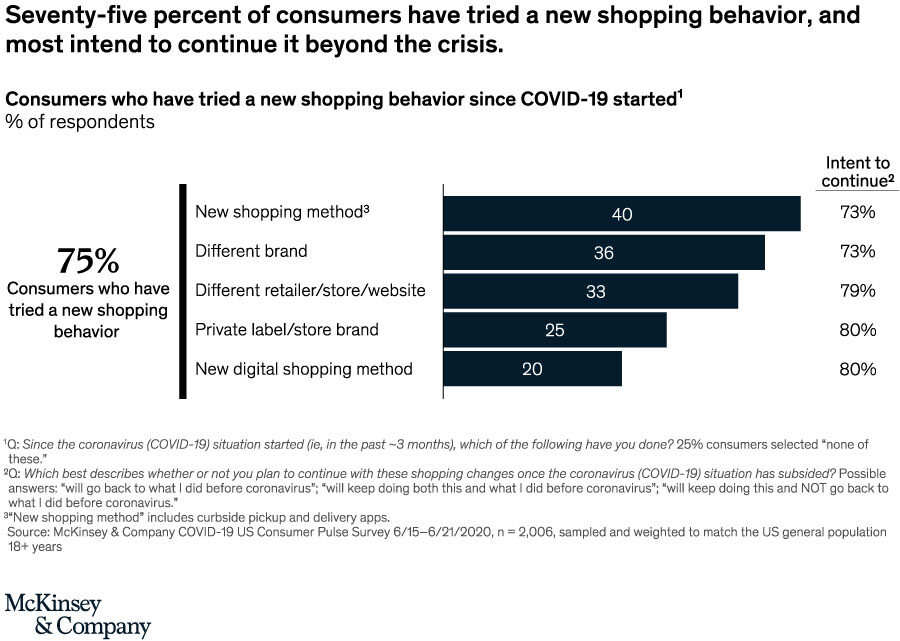For years now, decades even, we’ve heard about the digital shift in consumer behavior. We all knew the digital transformation was coming, but we expected it to happen gradually. Then, the unexpected happened.
Suddenly, in a matter of weeks, a major portion of consumer spending shifted online. Companies were left scrambling to adjust to wildly new patterns in how consumers shop, work and spend their leisure time. Otherwise, solid business models and business strategies were completely upended.
“At the height of the COVID-19 pandemic, 10 years of ecommerce growth happened in just 90 days.”
Shopify, The Future of Ecommerce
No one can be blamed for being caught off guard by such a compressed time frame. This chart shows the striking increase in online orders in 2020 (orange line) as the pandemic set in compared to 2019 (blue line):
 Online demand has plateaued roughly 63% higher than it was in 2019. The question now is whether this behavior will stick. Will consumers continue to appreciate the convenience of online shopping, or will they revert to the sensory thrills of the in-person retail experience when they feel safe enough?
Online demand has plateaued roughly 63% higher than it was in 2019. The question now is whether this behavior will stick. Will consumers continue to appreciate the convenience of online shopping, or will they revert to the sensory thrills of the in-person retail experience when they feel safe enough?
Only time will tell for sure, but consumers report that they intend to continue shopping online after the acute coronavirus pandemic passes. According to a survey by McKinsey & Company, we can expect an average of between 15-30% growth in online shopping across consumer categories, with OTC medicine (+44%), groceries (+41%), and household supplies (+38%) topping the list in the United States.

The future of online shopping appears to be bright, but it’s not all roses for digital marketers. The accelerated digital shift brings opportunities, but it also brings challenges. For instance, Shopify reports that record ecommerce competition is driving up customer acquisition costs.
Teams that adapt will capitalize on the new normal, while teams that fail to adapt will be left behind as their competitors steal market share. How can your marketing team keep up?
Ensure Online Availability through Cross-Company Communication
Shoppers cite lack of availability as one of the key reasons they’re switching brands and online retailers. While marketers aren’t typically responsible for handling logistics and supply chains, inter-departmental communication from the marketing team detailing the digital shift underway may provide insight that will help business operations understand the market forces at play so they can route inventory away from brick-and-mortar storefronts to warehouses where it’s available for online ordering.
Adopt New Digital Communication Channels
Consumer communication preferences are more nuanced than “online” and “offline.” Online communication includes email, live chat, social media messaging, SMS/texting, support tickets, and more. People have their preferences — often, strong preferences. So strong they’ll seek out companies that communicate with them the way they like to communicate.
By offering as many online communication options as possible, you allow the consumer to choose their preferred method — making doing business with your company as smooth and frustration-free as possible.
Now is a great time to add new messaging options such as live chat, chatbots or integrate Facebook Messenger into your pre and post-sale communication strategy.
Stress-Test your Digital Infrastructure
Can your hosting, support, and order processing systems handle a surge upon a surge?
Work with your DevOps team to ensure the infrastructure supporting your digital experience is capable of scaling — not just the increased pandemic traffic — but any growth in the future. Whenever possible, adopt solutions built on scalable cloud-based infrastructure like Google Cloud and AWS, so load capacity is never an issue. Pandemic aside, the amount of online consumers is only projected to grow year over year. The infrastructure that supported you in the past may not be future-proof.
Double Down on Online Reputation Management
Consumers are trying new brands. Brand loyalty continues to erode, especially among younger generations. Your company could benefit from a consumer breaking ties with a competitor — but only if their pre-purchase research points to you as a better option.

Invest in Customer Marketing
With customer acquisition costs up, keeping customers has never been more of a priority. To keep your customers from leaving, continue to strengthen your relationship with them after purchase, and optimize your customer experience. One way to focus on customers that warrant additional attention is to leverage a tool many companies have already adopted, the Net Promoter Score.
Each customer’s NPS rating is a convenient way to find your happiest customers (Promoters) and your customers in danger of leaving for competitors (Passives and Detractors). Once a customer has given you a score, use automated marketing or even human touch from your Sales or Customer Success team to address their concerns and create customer loyalty.
Lean into Marketing, Sales, and Support Automation
While “marketing automation” has become the industry term, don’t get trapped into thinking of marketing automation platforms strictly as marketing tools. The same automation tools that deliver perfectly-timed personalized experiences can be leveraged by Sales and Customer Success teams to strengthen customer relationships.
Automated messaging need not be annoying or intrusive, and the goal is not to avoid human contact. A well-executed automated messaging strategy actually facilitates human touchpoints rather than replacing them. For instance, an automated email might send an invite to schedule an appointment with a Customer Success rep after a customer achieves a certain milestone.

Create Immersive, Highly-Visual Digital Experiences
Today’s online consumers expect more than clip art and stock photography. Brands that are able to provide immersive digital experiences stand out and make a lasting impression.
These digital experiences need not be budget breakers. While an Augmented Reality demo might be out of budget, 360-degree product photography can give the consumer a much better impression of your product and give you an edge over competitors who display 2D product images.
When it comes to creating these experiences, moving quickly from ideation to usable visual assets is critical. This is where a tool like StudioNow becomes essential. By helping your creative team streamline the process of refining the creative brief, finding photographers and videographers, and providing feedback on the digital assets, you can move from campaign ideation to live in weeks rather than months, beating your competition to the punch with an impactful, timely omnichannel campaign. In an era of shifting priorities and cutthroat online competition, nimble campaign execution matters; visual campaigns are what smart brands are investing in.
If this is your first time dipping your toes into a marketing campaign that uses custom creative assets, check out our guide to writing a creative brief.
Consolidate Data in a Centralized Source
Creating personalized customer journeys in real-time requires data availability across digital channels and devices. Siloed data is impotent data.
If your marketing department struggles with this, you’re not alone. During an August 2020 Marketing Week and SalesForce Marketing Round Table, the top challenges named were:
- Creating cohesive customer journeys across channels and devices,
- Unifying customer data sources from an ecosystem of marketing tools,
- Sharing a unified view of customer data across business units,
- Engaging customers in real-time.
This list sounds familiar to digital marketing teams, small and large, across all industries worldwide. Note that all of these challenges were exacerbated by the pandemic.
This is one of those marketing initiatives that is easy to put off because it’s technically challenging, resource-intensive to complete, and overwhelming in scope. It’s a whale of a project, so it’s best eaten one bite at a time.
Take the first step and sign up for a service like Segment. Get the ball rolling by including development team members with API experience and the more technical members of your marketing team in onboarding calls.
Again, don’t aim for perfection or even fast progress. Be happy with slow but continual movement in the right direction. Meet monthly and set very attainable goals, with the ultimate goal being complete centralization of real-time data. You will fall far short of that goal at first, and that’s fine. Think in terms of years. Set that expectation upfront. Don’t make perfect the enemy of good. Don’t put this off because you don’t have the resources to do it perfectly right out of the gate.
Explore Machine Learning and Artificial Intelligence
While ML and AI have become easily dismissed buzzwords in marketing copy and dubious reasons for startups to get funding, it's becoming practical technology with cost-effective applications for marketers — particularly with optimizing paid ads and marketing automation campaigns.
If you're a CMO or marketing leader struggling to keep pace with a world that won't stop moving, it might be helpful to have some artificial intelligence in your corner, sharing some of the workload, crunching the data, and helping to make predictions about where the ball is headed.
Get Agile
One thing is certain: for the foreseeable future, we can expect rapid changes in consumer behavior. We need to question what we once took for granted.
“Track, Test, Learn, and Adapt” has always been the mantra of smart marketers. Now it’s the only way forward. The pandemic brought on unexpected changes in lifestyle and corresponding changes in consumer behavior. What will our lives and spending habits look like one year from now? So much is unknown.
Companies that measure the coming shifts and adapt as quickly as possible will perform best in the coming months as the vaccine rolls out and we discover what the “new normal” actually is.
Only time and data can tell, and agile marketing teams will know before anyone else.
 Visual Production Platform
Visual Production Platform

 Online demand has plateaued
Online demand has plateaued 




